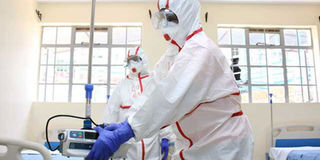Beware: Virus outbreak may lead us down the KeZombie Apocalypse

Medics test protective gear at Mbagathi Hospital during the launch of an isolation and treatment centre for the new coronavirus disease -2019, dubbed Covid-19, in Nairobi on March 6. PHOTO | FILE | NATION MEDIA GROUP
What you need to know:
- Virus progression took a familiar trajectory as witnessed in other countries.
- The death rate in a country with inadequate health services was projected at 10 per cent of those infected; 100,000 deaths in under three months!
- The biggest fear about a lockdown was that a country ravaged by corruption would have nothing to sustain a populace that largely lived hand-to-mouth.
It had begun with just one individual; an isolated case and no need to panic as long as all who had come into contact with Patient Zero were swiftly rounded up isolated.
That the victim had flown in from the United States provided room for comfort in KeZombiestan. It showed that the virus was foreign, largely afflicting populations in faraway continents.
It was also racially selective, mostly sparing Africans even as it left a trail of destruction in China, where it was first diagnosed, before spreading to nearby Asian countries to then find root in Europe and the US.
Virus progression took a familiar trajectory as witnessed in other countries. One became two. Two became four. Four became eight. By Day 10, eight had become 16 and predictions of a doubling of infections every few days were proved correct.
SOUND ALARM
Still, the authorities did not want to sound the alarm. They found comfort in reporting that all the confirmed infections so far had been brought from other countries.
But there was something the authorities were not revealing. Way before Patient Zero, soon after the disease that came to be called Novel Coronavirus, or Covid-19, was reported two months earlier, epidemiologists — the boffins who map incidents, spread and distribution of disease — from KeZombiestan’s top medical institutions had started mapping scenarios.
The results were sobering. The worst-case scenario showed that if the virus took root with no intervention to check the spread, it would take just eight weeks for a million KeZombies to be infected. That translated two per cent of the 50 million population.
The death rate in a country with inadequate health services was projected at 10 per cent of those infected; 100,000 deaths in under three months! The longer-term numbers were too frightening to contemplate.
There were various other projections looking at outcomes from different levels of compliance to advice on personal hygiene, washing and sanitising hands, disinfecting surfaces and premises and limiting physical interaction. Also looked at was effectiveness of directives limiting free movement and gatherings, all the way up to 24-hour curfews.
None of the scenarios drew rosy pictures, with the best cases showing close to 100,000 infections and over 10,000 deaths in the short term of the first three months.
SHOCK AND DISBELIEF
The top political leadership reacted with shock and disbelief and decided to act. But from the word go, it was timid, tentative steps. The new Health minister came across as earnest and determined, but seemed held back by the enormity of the task at hand.
He went big on preaching personal hygiene and social distancing, quarantine and self-isolation, as well limitations on movement and gatherings.
However, he could see widespread defiance as KeZombies continued their usual nightclub binges and loud, overcrowded church services. He had neither the heft nor clout to decree early lockdown, a measure that was preserve of el Presidente.
The biggest fear about a lockdown was that a country ravaged by corruption would have nothing to sustain a populace that largely lived hand-to-mouth. A hungry man is an angry man.
The Catch-22 situation resulted in timid steps that did not slow down the virus. By Week 12, new infections were outstripping even the worst-case scenarios.
The sheer numbers overwhelmed the rudimentary health services. Hospitals were flooded with patients dying in the corridors and courtyards.
The medical staff could not cope, drugs ran out and there was no treatment even for those who could have been saved. Infections spiralled out of control. The death toll rose. Meanwhile, the economy was suffering severe shocks and hundreds of thousands were laid off.
LAWLESS MOBS
That was the beginning of political unrest, and the stage at which the government declared a State of Emergency. The military was drafted in from the barracks to force people off the streets. Carnage ensued as increasingly desperate and defiant citizens faced down the soldiers.
Riots, looting and plunder spread across the country. Armed mobs roamed the streets, taking potshots at soldiers and stealing their weapons. Some soldiers, many unpaid, disgruntled and suffering the same helplessness as the civilians, abandoned their lines and joined the lawless mobs.
Soon enough, rival militia, some fuelled by narcotic drugs and the fatalism of a coronavirus death sentence, were going at each other with savage ferocity.
It had become a KeZombie apocalypse. And, for once in Africa, the blundering leaders had nowhere to run. Their overseas money laundries and fleshpots — London, Dubai, Zurich, Bangkok, Paris, Rome, et al — were all reeling under coronavirus and economic meltdown.
The end.
[email protected] www.gaitho.co.ke @MachariaGaitho





